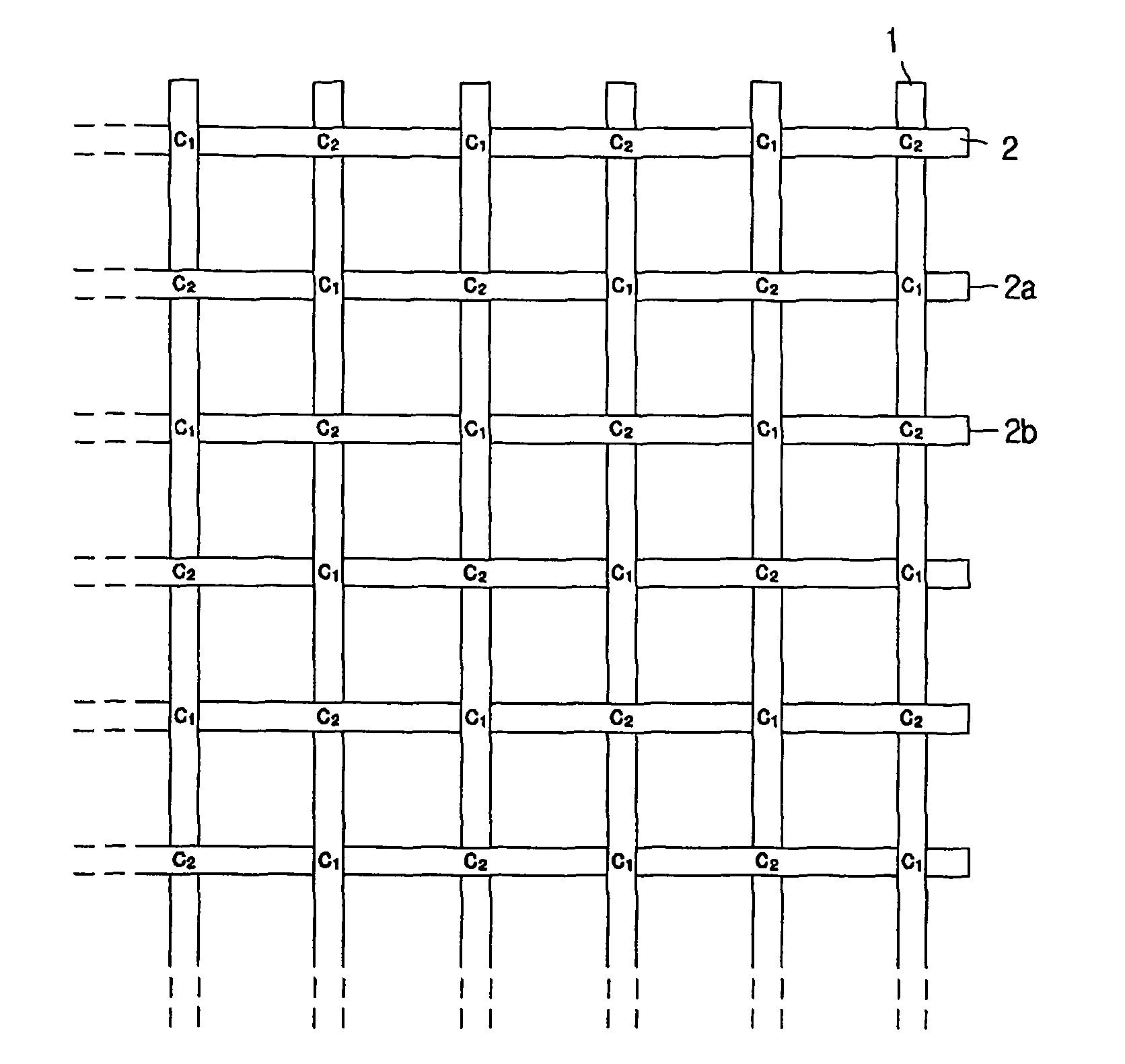Method for producing geogrid
a geogrid and production method technology, applied in the field of geogrid, can solve the problems of deterioration of installation resistance, deterioration of structural stability, and likely damage to textile geogrids, and achieve the effects of improving installation resistance, excellent shape stability, and increasing resistance to vertical load
- Summary
- Abstract
- Description
- Claims
- Application Information
AI Technical Summary
Benefits of technology
Problems solved by technology
Method used
Image
Examples
embodiment 1
[0102]A polyester high-tenacity fiber bundle of 48000 deniers is passed through a nipple having a rectangular section and through a rectangular die to make a longitudinal fiber-reinforced polymer strip having a section shown in (a) of FIG. 11a with a width of 8.4 mm and a thickness of 2.3 mm. In addition, a lateral fiber-reinforced polymer strip having the same section as the longitudinal fiber-reinforced polymer strip with a width of 6.3 mm and a thickness of 1.5 mm is made with the use of polyester high-tenacity fiber bundle of 20000 deniers. Polypropylene having a melt index of 4 is used as a thermoplastic polymer resin. Then, the longitudinal fiber-reinforced polymer strips are arranged on the strip arranging unit so that a product width is 4 m and a distance between the strips is 40 mm, and then the lateral fiber-reinforced polymer strips are inserted at an interval of 50 mm to have an angle of 90° with the longitudinal strip, thereby making a lattice having a plain weave struc...
embodiment 2
[0103]Two polyester high-tenacity fiber bundles of 24000 deniers are passed through a two-hole nipple having a rectangular section and through a rectangular die to make a longitudinal fiber-reinforced polymer strip having a section shown in (b) of FIG. 11a with a width of 8.4 mm and a thickness of 2.3 mm. In addition, a lateral fiber-reinforced polymer strip having the same section as the longitudinal fiber-reinforced polymer strip with a width of 6.3 mm and a thickness of 1.5 mm is made with the use of two polyester high-tenacity fiber bundles of 10000 deniers. Then, the strips are arranged in the same way as the first embodiment to produce a geogrid. The number of ribs per unit length (ribs / m), a wide-width tensile strength (kN / m), LASE5% (kN / m). a tensile strain (%), a creep strain (%) and a strength reduction rate (%) under construction of the produced geogrid are shown in the following table 1.
embodiment 3
[0104]Three polyester high-tenacity fiber bundles of 16000 deniers are passed through a three-hole nipple having a rectangular section and through a rectangular die to make a longitudinal fiber-reinforced polymer strip having a section shown in (c) of FIG. 11a with a width of 8.4 mm and a thickness of 2.3 mm. In addition, a lateral fiber-reinforced polymer strip having the same section as the longitudinal fiber-reinforced polymer strip with a width of 6.3 mm and a thickness of 1.5 mm is made with the use of four polyester high-tenacity fiber bundles of 5000 deniers. Then, the strips are arranged in the same way as the first embodiment to produce a geogrid. The number of ribs per unit length (ribs / m), a wide-width tensile strength (kN / m), LASE5% (kN / m), a tensile strain (%), a creep strain (%) and a strength reduction rate (%) under construction of the produced geogrid are shown in the following table 1.
PUM
| Property | Measurement | Unit |
|---|---|---|
| crossing angle | aaaaa | aaaaa |
| crossing angle | aaaaa | aaaaa |
| crossing angle | aaaaa | aaaaa |
Abstract
Description
Claims
Application Information
 Login to View More
Login to View More - R&D
- Intellectual Property
- Life Sciences
- Materials
- Tech Scout
- Unparalleled Data Quality
- Higher Quality Content
- 60% Fewer Hallucinations
Browse by: Latest US Patents, China's latest patents, Technical Efficacy Thesaurus, Application Domain, Technology Topic, Popular Technical Reports.
© 2025 PatSnap. All rights reserved.Legal|Privacy policy|Modern Slavery Act Transparency Statement|Sitemap|About US| Contact US: help@patsnap.com



